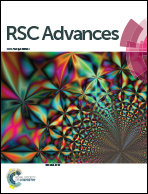Fe3O4 nanoparticles and ultrasound assisted dispersive liquid–liquid microextraction of lead(ii) for its microsampling flame atomic absorption spectrometric determination in food and environmental samples
Abstract
A method for the isolation of lead from aqueous samples as a Chicago sky blue 6B chelate, based on the combination of Fe3O4 nanoparticles and ultrasound assisted dispersive liquid–liquid microextraction (NPU-DLLME) prior to flame atomic absorption spectrometry, was developed. The amount of Fe3O4 nanoparticles added and the length of ultrasound exposure were optimized, and quantitative recovery was achieved at pH 6. The limit of quantification for solid samples was calculated to be 8.5 mg kg−1. The relative standard deviation (RSD) determined for a standard solution containing 4.5 μg Pb(II) was 2.7%. The evaluation of accuracy was performed with wastewater and corn bran certified reference materials. This method was applied for the determination of lead in water and a few spices.


 Please wait while we load your content...
Please wait while we load your content...